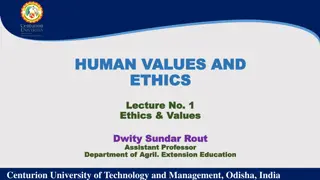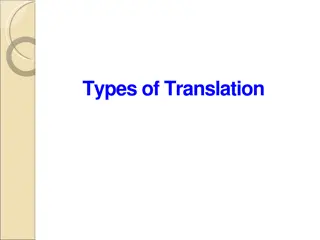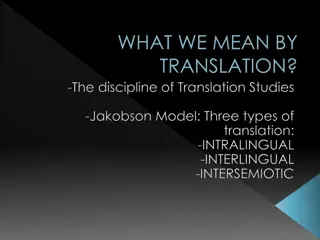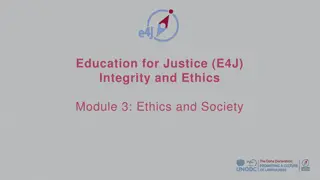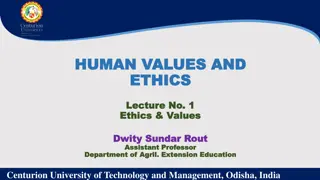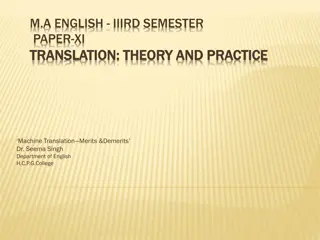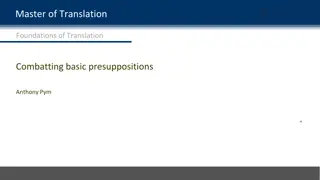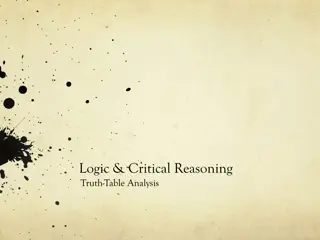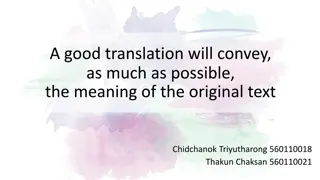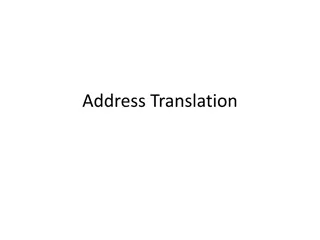Seminar on Truth, Trust, and Cooperation in Translation Ethics
Dive into the complexities of translation ethics by exploring concepts from Berman's textual ethics and Pym's ethics in the context of real-world translation practices. Reflect on the genre-dependent nature of ethics in translation and contemplate the translator's role in today's multicultural landscape. Delve into practical examples such as translating culture-bound terms like "Yorkshire pudding" and interpreting proverbs across languages. Discover guidance from Antoine Berman on the twelve deforming tendencies in translation. Enhance your understanding of language and culture through thought-provoking discussions at this seminar.
Download Presentation

Please find below an Image/Link to download the presentation.
The content on the website is provided AS IS for your information and personal use only. It may not be sold, licensed, or shared on other websites without obtaining consent from the author.If you encounter any issues during the download, it is possible that the publisher has removed the file from their server.
You are allowed to download the files provided on this website for personal or commercial use, subject to the condition that they are used lawfully. All files are the property of their respective owners.
The content on the website is provided AS IS for your information and personal use only. It may not be sold, licensed, or shared on other websites without obtaining consent from the author.
E N D
Presentation Transcript
TRUTH, TRUST, AND COOPERATION SEMINAR
Tying ideas from Berman s textual ethics and Pym s ethics to concrete examples of translation practice Questioning the genre- dependent nature of ethics Questioning our role as a translator TODAY S SEMINAR
WARM UP: YORKSHIRE PUDDINGS When translating a culture-bound term like Yorkshire pudding there are multiple options available: Paraphrase replacing the term with something along the lines of a traditional English side dish , for instance; Omission simply leaving it out; Borrowing or Calque retaining the foreign element e.g. Yorkshire pudding in a Spanish text, or transliteration; Explanation e.g. retaining the term Yorkshire pudding along with an explanation of what it is and its cultural significance; Use an equivalent (or approximate equivalent) e.g. choose a similarly common side dish in your target language culture. What is the right way to translate here? This list is not exhaustive, but demonstrates the range of possible responses.
TRANSLATING PROVERBS Imagine you are translating a text from English and you come across the following proverb: It s raining cats and dogs . How would you go about translating it? French: Il pleut seaux [It s raining buckets] Russian: [Rain is pouring as if from a bucket] Mandarin: [Basin-bending big rain is falling] Norwegian: Det regner trollkjerringer [It s raining troll women] In each case, the translation uses a recognised equivalent in the TL. while this would be commonly used in many contexts, this is precisely what Berman is arguing against as it fails to represent the Other (the foreign language and culture) as Other. In transforming the Norwegian troll women into cats and dogs , we are losing something that he sees as vital to the language. Initial reflection: What do you make of these ideas on language and culture?
MORE GUIDELINES: THE TWELVE DEFORMING TENDENCIES Rationalisation The destruction of rhythms Clarification The destruction of underlying networks of signification Expansion The destruction of linguistic patternings Ennoblement or popularisation The destruction of vernacular network or their exoticisation Qualitative impoverishment Quantitative impoverishment The destruction of expressions and idioms The effacement of the superimposition of languages Berman, Antoine (1985) Translation and the trials of the foreign , in Lawrence Venuti (ed.) The Translation Studies Reader, London/New York: Routledge, 284-97.
QUESTIONS ON THE DEFORMING TENDENCIES Which of these tendencies do you feel is the most important when translating a text? Do you believe that all twelve of these tendencies are a negative feature? Can they be avoided when translating? To what extent do these deforming tendencies apply within the languages you work in, and contexts that you are familiar with? For instance, do they apply if you are translating an instruction manual?
ST: La carrire de Gigi Riva est d'une simplicit biblique, comme un long fleuve tranquille dans une le enchant e TT: Gigi Riva was famously a one-club man Is this unethical? [Gigi Riva s career is/was of stunning (biblical) (epic?) simplicity, like a long, calm river on an enchanted island] What about Pym s ethics? IN A PROFESSIONAL CONTEXT
COOPERATION, PURE CONSEQUENTIALISM The approach does not assume any symmetry or equality of the communication participants; it does not require any pre-established community of purpose: as long as both sides benefit, no matter how unequally, then the interaction is considered cooperative and thus ethically good. Pym 2020:151
SOME QUESTIONS FROM PYM What do you make of the idea of cooperation? Can we always judge cooperation in such a detached way?
AN EXAMPLE A literary translator, Stefan Moster, translates a Finnish novel by Arto Paasilinna into German. In this story set in Finland s pagan past, a semi- divine hero is born, who will save Finland from the threat of the new Christian religion. The hero is born on April 20. But the German version says he is born on April 19. Why? Extracted from Chesterman 2018 on Translation Ethics, full example in Chesterman 2009 An Ethical Decision Ukkosenjumalan poika (1984), literally Son of the Thunder God , by Arto Paasilinna (b. 1942), a well-known Finnish novelist.
AN EXAMPLE Because April 20 was Hitler s birthday. Many German readers will know this, so there is a risk that the novel will be taken as neo-Nazi propaganda, and this is a risk the translator refuses to take. On his own responsibility, he changes the date. He informs the German publisher, but not the author. Asking the author s permission would have run the risk of being refused, and this risk too he did not wish to take. Later (Moster 2003), he makes the reasons for his decision public. Extracted from Chesterman 2018 on Translation Ethics, full example in Chesterman 2009 An Ethical Decision Ukkosenjumalan poika (1984), literally Son of the Thunder God , by Arto Paasilinna (b. 1942), a well-known Finnish novelist.
FROM THE TRANSLATOR Recognising the date and the significance with regard to Hitler, he feared that readers would interpret the ending of the novel as referring to a Nazi saviour who will improve the gene-pool of the nation (ibid.). In a 2003 article in the magazine Books from Finland* Moster argues as follows: Quite possibly, the book had what it took to become a cult novel in right-wing circles, and I did not want to let that happen to it or, most of all, to me for which reason I replaced 20 April with another date. And I did not actually ask the author, as I am wont to do in similar cases, for I wanted to avoid him disallowing the (to me) essential modication [sic]. In doing so I valued my stake as originator of the text more highly than that of the author. Is that allowed? Yes, when you think you have to do it. Is it a problem? Not really, when you know what you re doing. Moster 2003: 60 A quarterly publication presenting the latest Finnish fiction and poetry in English, with news from the world of Finnish literary translation publishing
QUESTIONS 1. In this case, what would you do? Or what should we do as a translator? And why? Again, is it the principle of loyalty that guides us? 2. In terms of Pym s ideas, is cooperation achieved? What about notions of risk and trust? 3. In what ways can we say the translator was/was not loyal and to whom? 4. In terms of cultural mediation, can the translator realistically flag issues to the client every time something problematic comes up? This is an extreme example, but where do we draw the line?
SOME THOUGHTS FROM CHESTERMAN One can query Moster stextual solution (why not just in the spring ?), but his decision to delete the original date can be respected. The ethical justification is utilitarian: possible undesirable consequences weigh more heavily than being true to the original, and also more heavily than consultation with the author. The translator has demonstrated loyalty to the publisher, and perhaps to the author on the understanding that there was no intention that the novel should have a Nazi undertone ( most unlikely). By bringing the issue into public debate, Moster exploits the translator s extratextual visibility and highlights the responsibility of the professional.
SOME THOUGHTS FROM CHESTERMAN He has certainly not treated the text in a neutral way, but has intervened, in defence of his own ideology against an opposing one. Has he placed his personal ethics above his professional ones? No, if it is granted that he has acted professionally, in the wider interests of intercultural relations, of long-term cooperation. He is clearly concerned with more than merely textual relations. The matter is made even more complex by a further twist. April 20 also happens to be the author s birthday. Not many Finnish readers would have known this, but it is quite likely that Paasilinna enjoyed this as a kind of in-joke. And Paasilinna himself may not have been aware that the day was also Hitler s birthday.
What do you think about this course of action? What would you do as the translator? Where does the Foreign and cooperation come in here? CENSORSHIP AND AGENCY
HIROSHIMA, MOKUSATSU AND ALLEGED MISTRANSLATIONS (esnbu.org) MOKUSATSU - ignore , take no notice of or treat with silent contempt. Two kanji characters: (moku - silence) and (satsu - killing). In July 1945, allied countries submitted harshly worded declaration of surrender terms. After their terms were translated into Japanese, they waited for the Japanese reply from Prime Minister, Kantaro Suzuki. This ultimatum demanded Japan's unconditional surrender. The terms included a statement to the effect that any negative answer from Japan would invite "prompt and utter destruction. Suzuki responded using the term mokusatsu and international news agencies reported to the world that the ultimatum was ignored . In 1950, Kazuo Kawai argued that the translation of ignore in the response was fatal and asserted that a correct translation as withhold comment would have prevented the tragedy. An inflammatory take on it is still given by sensationalist blogs with headlines like The Biggest Translation Mistake Ever! actually, their usage of the example is ethically questionable in a way.
SOME QUESTIONS Who is in control of the meaning of a translation? How could we achieve long-term cultural cooperation in this context? What impact does the use of examples like this have on trust in translation? How does this example relate to the concept of risk?
NEXT WEEK (OR RATHER, IN WEEK 6) Baker, Inghilleri, Activism and Justice A more relativist, context-based, personal view of ethics
EXAMPLES LINKING ETHICS AND TRANSLATING The following texts are taken from a range of real-world contexts. Considering the translation theories explored, what ethical issues do the texts bring up? (Or, do the texts raise any ethical issues at all?) What challenges arise from Berman s ideas (the need to respect the rhythms, sounds, length (or concision) and lexico-grammatical makeup of the original) or the professional norms of translation that require translators to produce a text that does not show any trace of having been translated? Can we realistically apply Berman s literalising translation methodology while still considering other parties such as the end client or the target audience or would we have to produce entirely different texts? To what extent are these questions genre-dependent? What about Nord s conception of Function plus loyalty ? To what extent can we remain loyal to the source text author, the target audience and the commissioner of the work when translating each text? What do you base your approach on?
101 THINGS A TRANSLATOR NEEDS TO KNOW #29 Turning Junk into Gems A good translator can usually find subtle ways of turning copy produced by a less capable writer into something easier to read and more convincing than the original. That s often precisely what demanding clients want even if they don t say so up front. It s part of the added value a skilled professional translator brings to the table. But to be on the safe side, check with your buyer. Clarify the translation s purpose and target readership. And give a few examples, so the client can see and understand how you might make their text sing or stick with the awkwardness, if that s what is really, truly required. Falling back on a garbage in, garbage out defence is unlikely to endear you to anyone, especially if you trot it out after the event. http://www.rfi.fr/emission/20160329-joutes-traduction Podcast on the challenges of translating this passage (in French)
A NOCTURNAL UPON ST. LUCY'S DAY, BEING THE SHORTEST DAY - JOHN DONNE Tis the year's midnight, and it is the day's, Lucy's, who scarce seven hours herself unmasks; The sun is spent, and now his flasks Send forth light squibs, no constant rays; The world's whole sap is sunk; The general balm th' hydroptic earth hath drunk, Whither, as to the bed's-feet, life is shrunk, Dead and interred; yet all these seem to laugh, Compared with me, who am their epitaph.
RAVIOLI RAVIOLI DURUM WHEAT PASTA WITH FROZEN SPINACH AND RICOTTA FILLING Ingredients: Pasta 45%: durum WHEAT semolina, water. Filling 54%: Ricotta 87% (sheep s MILK whey (A)* or cows MILK whey (B)*), breadcrumbs (type 0 WHEAT flour, yeast, salt), spinach 5% EGG, WHEAT flour, salt, nutmeg, parsley, pepper. (*See letter next to batch number) General instructions: For optimal results, consume by best before date and follow storage instructions provided on the pack. Once defrosted, keep refrigerated and consume within 24 hours. Do not refreeze. Product must be cooked before eating. Cooking instructions: Hob: Cook from frozen. To prevent ravioli from sticking, the product should not be defrosted. Pour ravioli into a pan of boiling, salted water and boil for around 6/8 minutes until cooked to taste.




